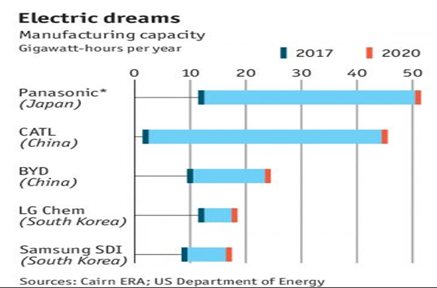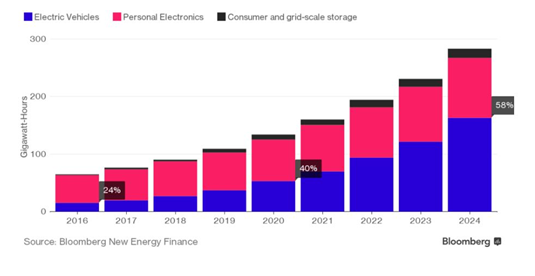As a general rule, the most successful man in life is the man who has the best information.
Our ‘who cares’ attitude towards pollution and habitat destruction are all increasing what were once tolerable pressures towards, and sometimes already beyond, the breaking point in ecosystems all over the world.
Fortunately, people, governments, and corporations are waking up and trying to reduce their carbon footprint.
Our attitude toward environmental issues is changing, we are responding to potentially catastrophic climate change and to global (and all the way down to the micro-local and individual levels of), environmental degradation.
One of the results of our rising awareness, and taking personal responsibility for our own actions, is that we are in the early stages of a major, decades-long transition in how energy is produced and stored. A global energy transition, from the burning of fossil fuels for energy and transportation, to using renewable non-polluting solar and wind energy is underway.
Lithium powers many of today’s handheld tools, our modern mobile communications, our computing devices and increasingly our transportation system. Lithium-ion is the leading energy storage technology, one cannot understate its importance in transforming not only communications gadgets into marvels of handheld technology but in taking electric cars from a niche curiosity into a major clean energy revolution for the transportation sector.
“The top five lithium ion battery manufacturers are ramping up capital expenditure with a view to almost tripling capacity by 2020.” The Economist

China and India are both going to 100% electric vehicles. Every major car manufacturer has electric models.Volvo has even promised to phase out traditional internal combustion engines (ICE) from 2019.
France has promised to end the sale of gasoline and diesel vehicles by 2040, the U.K. quickly followed suit.
Gigafactory’s making lithium-ion batteries for electric vehicles are springing up across the globe.
Tesla’s Nevada Gigafactory, to be completed in 2018, will produce more lithium-ion batteries than were produced globally in all of 2013. Elon Musk, Tesla's (NASDAQ:TSLA) CEO has already announced plans to build four more Gigafactory’s.
By 2021, Chinese Gigafactory’s will provide 3.5 times more gigawatt-hours of battery cells than Tesla’s current Gigafactory.
Europe recently announced five Gigafactories will be built.
Bloomberg reports that global battery-making capacity is set to more than double by 2021, topping 278 gigawatt-hours a year compared to 103 gigawatt-hours at present.
“Lithium isn’t a bubble, it’s a fundamental change in energy usage.” financialpost.com

Morgan Stanley (NYSE:MS) analysts project that by 2050, 81% of 132 million new auto sales will be electric.
Danger Will Rogers
There’s a looming problem.
“It’s not clear that the resource supply chains exist yet for all these factories.” David Hart, director E4tech
Translation – There isn’t enough lithium currently being mined to supply all those Gigafactory’s.
“We estimate the lithium industry is going to need between $4-$5 billion of investment out to 2025.” Simon Moores, Benchmark Minerals Intelligence


The potential for supply-demand gaps to open up over the coming decade is significant, a supply shortage of lithium will cause major issues in the battery supply chain.
Elon Musk said, in 2016: “In order to produce half a million cars a year … We would basically need to absorb the entire world’s lithium-ion production.”
Exposure to lithium
With the massive coming increase in demand for lithium – because of the massive swing away from burning fossil fuels to a battery fueled transportation system still in its infancy – and a supply chain not capable of meeting the increase now is a great time to be looking at select lithium stocks.
Be warned, lithium prices aren’t cheap. Lithium focused companies had a great 2016. For most, the trend continued into 2017. Some have seen a pullback in share price and in your author’s opinion are at an attractive entry point.
Production and near-term production stories would seem to offer the best leverage, or exposure, to rising lithium demand.
Market share for the “Big 3” lithium producers, the New York listed chemical companies Albemarle, Sociedad Quimica y Minera de Chile and FMC, has dropped from about 85 percent to 53 percent – China now has about 40 percent of the world’s market share.
Also listed are several near-term producers; Lithium Americas Corp., MGX Minerals Inc., and Nemaska Lithium.
Albemarle Corporation (NYSE:ALB)
After acquiring Rockwood Holdings in 2015 Albemarle inherited the U.S.’s only producing lithium mine, the Silver Peak lithium mine in Nevada.
Tesla (NASDAQ:TSLA), with its Gigafactory in Nevada, plans to produce as many as 500,000 battery packs per year and will consume nearly all of today’s current global annual lithium supply to do it.
Outside the U.S., Albemarle produces from its assets in the Salar de Atacama in Chile and from a 49% stake in the massive hard-rock Greenbushes mine in Australia where the company is planning on a doubling of production.
Albemarle has asked Chile’s government to allow it to raise its lithium production quota to 180K metric tons/year from the current 80K tons/year limit.
“Lithium isn’t a bubble, it’s a fundamental change in energy usage.” finacialpost.com
MGX Minerals (SNX:XMG)
Petrolithium focuses on concentrating lithium and other minerals from the abundant brine that accompanies oil and gas (O&G) production.
MGX has a patent pending, proprietary, low-energy process specifically designed to rapidly concentrate lithium and other minerals from highly-mineralized brines associated with oilfields. MGX’s patented technology separates heavy metals and hydrocarbons from brine, purifying the wastewater and creating a steady flow of brine feedstock for MGX’s recovery process.
The wastewater treatment industry is expected to grow into a $45 billion market annually by 2025, globally O&G producers are increasingly looking for opportunities to reduce wastewater handling costs. MGX has entered water/brine testing and analyses agreements with major oil companies across North America and has completed testing at more than 25 locations providing an initial pipeline of mineral and water handling projects.
MGX has also recently signed an agreement with Power Metals Corp. to acquire all of the company’s current U.S. petrolithium brine assets and a 20-per-cent working interest in all of the company’s current hard rock assets and any future assets that the company acquires for the next 36 months.
MGX Minerals also has magnesium and silicon projects.
Sociedad Quimica y Minera SA (NYSE:SQM)
The company’s largest assets are in the Salar de Atacama, or the Atacama Salt Desert – considered to have the highest lithium and potassium concentrations ever recorded.
Beyond its lithium business, SQM is also a significant potash producer and the world’s largest producer of iodine. SQM is the world’s lowest cost producer of lithium and is intent on greatly expanding capacity.
Many might consider SQM expensive as its stock sells for more than 40 times trailing earnings and 30 times forward earnings versus 25 times forward earnings for ALB and 18 times forward estimate for FMC Corp (NYSE:FMC).
FMC Corporation (NYSE:FMC)
FMC’s lithium operations are next to SQM, in the Salar del Hombre Muerto of Argentina.
FMC’s lithium segment jumped 45% in the first quarter of 2017 from the year before.
The company is fast ramping up its global lithium hydroxide production capacity to serve the growing electric vehicle market. In July, 2017 FMC Corp said it plans to expand lithium hydroxide capacity by 8,000 tonnes next year to 18,000 and further boost output to 30,000 tonnes over the next several years.
“There will be more EVs on offer than internal combustion engines 15 years from now.” Mark Fields, CEO Ford Motor Company (NYSE:F)
Lithium Americas Corp (TO:LAC)
Lithium Americas has a joint venture with Sociedad Quimica y Minera de Chile (SQM) for the Cauchari-Olaroz project in Jujuy, Argentina. Cauchari-Olaroz is believed to be the world’s third-largest lithium brine resource.
SQM and Lithium Americas plan to develop their JV Cauchari-Olaroz project with targeted production of 50,000 tpa of LCE.
The benefits of this joint venture include an opportunity for Lithium Americas to apply its recently gained operational know-how to its solely-owned Clayton Valley Lithium Nevada project.
“Lithium supply security has become a top priority for technology companies in the United States and Asia.” United States Geological Service
Nemaska Lithium (TO:NMX)
Nemaska Lithium is one of the only companies in the world looking to produce lithium hydroxide (the most valuable battery-grade lithium ingredient) directly instead of from lithium carbonate.
The spodumene concentrate produced at its Whabouchi mine in Quebec will be shipped to the Corporation’s lithium compounds processing plant to be built in Shawinigan, Quebec. This plant will transform the spodumene concentrate into high purity lithium hydroxide and carbonate using the proprietary methods developed by the Corporation, and for which the Corporation holds four patents.
Goldman Sachs (NYSE:GS), in 2016 said: “Every 1% increase in electric vehicle penetration would increase demand by 70k MT (LCE) per year.”
Conclusion
If, as the Financial Post says, lithium is a fundamental change in energy usage does that mean lithium is the new petroleum? Are internal combustion engines going to be replaced by more efficient energy technology much like petroleum replaced coal, and coal replaced wood?
Lithium is a strategic green metal. Grand View Research Inc., in its report, has placed the world lithium-ion battery market at $93 billion by 2025, with a 17% compound annual growth rate.
Investors should seriously consider Lithium as a long term hold with respect to this ever growing demand.
Legal Notice / Disclaimer
This document is not and should not be construed as an offer to sell or the solicitation of an offer to purchase or subscribe for any investment.
Richard does not own shares of any company mentioned in this report. No companies mentioned are advertisers on his site aheadoftheherd.com
